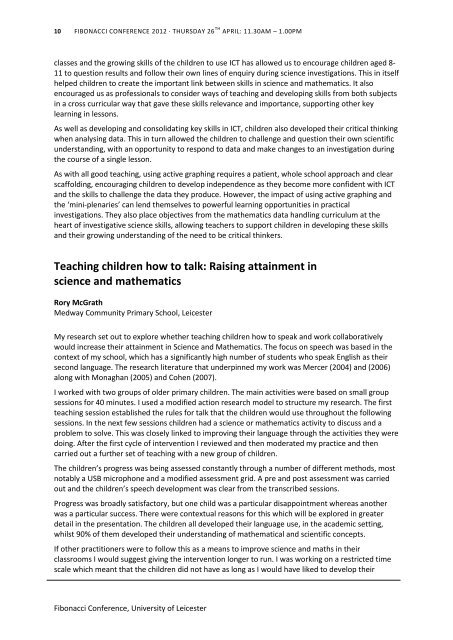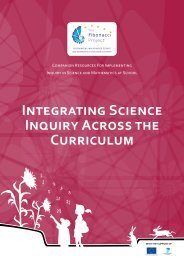disseminating inquiry-based science and ... - Fibonacci-Project
disseminating inquiry-based science and ... - Fibonacci-Project
disseminating inquiry-based science and ... - Fibonacci-Project
Create successful ePaper yourself
Turn your PDF publications into a flip-book with our unique Google optimized e-Paper software.
10 FIBONACCI CONFERENCE 2012 ∙ THURSDAY 26 TH APRIL: 11.30AM – 1.00PM<br />
classes <strong>and</strong> the growing skills of the children to use ICT has allowed us to encourage children aged 8-<br />
11 to question results <strong>and</strong> follow their own lines of enquiry during <strong>science</strong> investigations. This in itself<br />
helped children to create the important link between skills in <strong>science</strong> <strong>and</strong> mathematics. It also<br />
encouraged us as professionals to consider ways of teaching <strong>and</strong> developing skills from both subjects<br />
in a cross curricular way that gave these skills relevance <strong>and</strong> importance, supporting other key<br />
learning in lessons.<br />
As well as developing <strong>and</strong> consolidating key skills in ICT, children also developed their critical thinking<br />
when analysing data. This in turn allowed the children to challenge <strong>and</strong> question their own scientific<br />
underst<strong>and</strong>ing, with an opportunity to respond to data <strong>and</strong> make changes to an investigation during<br />
the course of a single lesson.<br />
As with all good teaching, using active graphing requires a patient, whole school approach <strong>and</strong> clear<br />
scaffolding, encouraging children to develop independence as they become more confident with ICT<br />
<strong>and</strong> the skills to challenge the data they produce. However, the impact of using active graphing <strong>and</strong><br />
the ‘mini-plenaries’ can lend themselves to powerful learning opportunities in practical<br />
investigations. They also place objectives from the mathematics data h<strong>and</strong>ling curriculum at the<br />
heart of investigative <strong>science</strong> skills, allowing teachers to support children in developing these skills<br />
<strong>and</strong> their growing underst<strong>and</strong>ing of the need to be critical thinkers.<br />
Teaching children how to talk: Raising attainment in<br />
<strong>science</strong> <strong>and</strong> mathematics<br />
Rory McGrath<br />
Medway Community Primary School, Leicester<br />
My research set out to explore whether teaching children how to speak <strong>and</strong> work collaboratively<br />
would increase their attainment in Science <strong>and</strong> Mathematics. The focus on speech was <strong>based</strong> in the<br />
context of my school, which has a significantly high number of students who speak English as their<br />
second language. The research literature that underpinned my work was Mercer (2004) <strong>and</strong> (2006)<br />
along with Monaghan (2005) <strong>and</strong> Cohen (2007).<br />
I worked with two groups of older primary children. The main activities were <strong>based</strong> on small group<br />
sessions for 40 minutes. I used a modified action research model to structure my research. The first<br />
teaching session established the rules for talk that the children would use throughout the following<br />
sessions. In the next few sessions children had a <strong>science</strong> or mathematics activity to discuss <strong>and</strong> a<br />
problem to solve. This was closely linked to improving their language through the activities they were<br />
doing. After the first cycle of intervention I reviewed <strong>and</strong> then moderated my practice <strong>and</strong> then<br />
carried out a further set of teaching with a new group of children.<br />
The children’s progress was being assessed constantly through a number of different methods, most<br />
notably a USB microphone <strong>and</strong> a modified assessment grid. A pre <strong>and</strong> post assessment was carried<br />
out <strong>and</strong> the children’s speech development was clear from the transcribed sessions.<br />
Progress was broadly satisfactory, but one child was a particular disappointment whereas another<br />
was a particular success. There were contextual reasons for this which will be explored in greater<br />
detail in the presentation. The children all developed their language use, in the academic setting,<br />
whilst 90% of them developed their underst<strong>and</strong>ing of mathematical <strong>and</strong> scientific concepts.<br />
If other practitioners were to follow this as a means to improve <strong>science</strong> <strong>and</strong> maths in their<br />
classrooms I would suggest giving the intervention longer to run. I was working on a restricted time<br />
scale which meant that the children did not have as long as I would have liked to develop their<br />
<strong>Fibonacci</strong> Conference, University of Leicester




